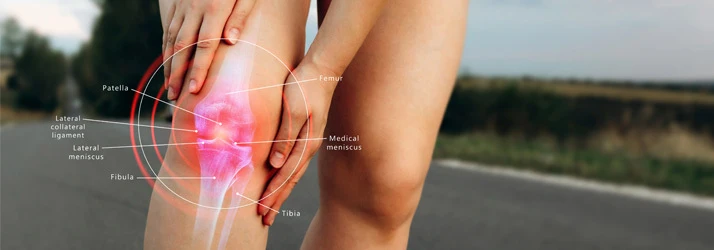Knee Regenerative Injections in Amarillo TX

Dr. Jeff Williams, owner of an integrated chiropractic clinic in Amarillo TX, explains a game-changer in preventing knee replacement surgery.
Platelet-Rich Plasma for Knee Pain in Amarillo TX
When it comes to knee pain and the prospect of knee replacement surgery, a groundbreaking solution has emerged in recent years - Platelet-Rich Plasma (PRP) therapy. This emerging and innovative treatment has captured the attention of medical professionals and patients alike, offering a true alternative to traditional surgical interventions and cortisone injections which can be detrimental to the joint structures. Let's dive into the world of PRP therapy, exploring its mechanisms, benefits, and its potential to prevent knee replacement surgery.
Understanding Knee Pain and Its Challenges
The Complexity of Knee Pain
Knee pain can stem from various sources, including injuries, osteoarthritis, and inflammation. It's a complex issue that affects millions worldwide, often leading to reduced mobility, discomfort, and a diminished quality of life.
The Conventional Approach: Knee Replacement Surgery
For severe cases of knee pain, cortisone shots that tear up the joints, hyaluronic acid injections and knee replacement surgery have been standard solutions. However, it's an invasive procedure that comes with risks, lengthy recovery periods, and potential complications.
Enter Platelet-Rich Plasma (PRP) Therapy
What is PRP Therapy?
PRP therapy involves extracting a small amount of the patient's blood, processing it to concentrate the platelets, and then injecting the platelet-rich solution back into the affected knee. Platelets contain growth factors that can promote tissue repair and regeneration.
The research concluded,
"Intra-articular injections of leukocyte-poor PRP can provide clinically significant functional improvement for at least 1 year in patients with mild to moderate osteoarthritis of the knee." Lin et. al.
That's a big deal for those suffering.
How Does PRP Work?
The growth factors released by platelets initiate the body's natural healing processes. They have the ability to stimulate cell growth, increase collagen production, and enhance blood flow to the treated area. This aids in reducing inflammation and promoting tissue repair.
The Benefits of PRP Therapy
Non-Invasiveness and Low Risk
Unlike knee replacement surgery, PRP therapy is minimally invasive and carries a significantly lower risk of complications. More than anything, PRP avoids the trauma and potential adverse effects of surgery.
Natural Healing Mechanism
PRP therapy harnesses the body's innate healing abilities. By utilizing the patient's blood, it encourages the body to repair itself naturally, leading to long-lasting results.
Shortened Recovery Time
Compared to the lengthy recovery process associated with knee replacement surgery, PRP therapy offers a quicker healing time (3-6 months). Patients can typically resume their normal activities the same day of treatment.
PRP Therapy as a Preventive Measure
Addressing Knee Pain Early
PRP therapy can be employed at the onset of knee pain or discomfort, potentially preventing the condition from worsening and avoiding the need for more invasive procedures later on.
Slowing Down Degeneration
For individuals with early-stage osteoarthritis, PRP therapy may slow down the degenerative process and delay or even eliminate the need for knee replacement surgery.
More recent research concluded,
"The present study showed significant decrease in pain and stiffness and improvement of physical functions of knee joint with intra-articular platelet-rich plasma injection as compared to normal saline."
Real-Life Success Stories
Linda's Journey to Pain Relief
Meet Linda, a 49-year-old avid outdoors person who was facing knee pain and shoulder pain that jeopardized her passion for the outdoors. Not only was she having pain, she was facing surgery on 3 different joints!
After undergoing PRP therapy for her knees and shoulders, Linda experienced remarkable pain relief and is now able to resume her outdoor adventures with ZERO PAIN.
Janet's Triumph Over Osteoarthritis
Janet, a 45-year-old professional diagnosed with mild osteoarthritis, was concerned about surgery. She was a very active person and would often go on runs of more than 10 miles at a time. But her knee pain forced her to stop running which, of course, led to less activity and a small amount of weight gain. Janet turned to PRP therapy, which not only alleviated her pain but also improved her overall joint function. Now, Janet is back to running more than 10 miles at a time any time she wants. She's back to enjoying her life pain-free. Not only that, but she didn't have to go through surgery to get there.
Amazing!
The Future of Knee Pain Management
Advancements in PRP Research
Ongoing research and technological advancements continue to refine PRP therapy, enhancing its effectiveness and expanding its applications.
Collaborative Approaches
Medical professionals are increasingly adopting a collaborative approach, combining PRP therapy with other treatments for optimized results.
In the realm of knee pain management, Platelet-Rich Plasma (PRP) therapy stands out as a game-changer. Its non-invasiveness, natural healing mechanisms and potential to prevent knee replacement surgery and cortisone injections make it a promising avenue for those seeking pain relief and improved joint function. By embracing PRP therapy, individuals can take proactive steps towards a more pain-free future.
FAQs
1. Is PRP therapy painful?
PRP therapy involves minimal discomfort, often comparable to a routine blood test.
2. How many PRP sessions are typically required?
The number of sessions can vary depending on the severity of the condition, but patients often notice improvements after just one or two sessions. Our normal protocol is 3 sessions over 3 months.
3. Are there any side effects of PRP therapy?
Side effects are rare and generally minor, including temporary swelling or bruising at the injection site.
4. Is PRP therapy suitable for all types of knee pain?
PRP therapy is most effective for mild to moderate knee pain and early-stage osteoarthritis. Creek Stone Amarillo TX is your place for PRP in Amarillo TX, and PRP in the Texas Panhandle.
5. How can I access PRP therapy?
You can access PRP right here at Creek Stone Integrated Medical & Spa. Creekstone Amarillo TX is the place in the High Plains for PRP, folks. Schedule an appointment today or give us a call at (806) 355-3000.
OFFICE HOURS
Monday
9:00am - 6:00pm
Tuesday
9:00am - 5:00pm
Wednesday
9:00am - 6:00pm
Thursday
9:00am - 6:00pm
Friday
8:00am - 1:00pm
Saturday
10:00am - 3:00pm
Sunday
Closed
Creek Stone Integrated Medical & Spa
3501 SW 45th Ave Ste. T
Amarillo, TX 79109



